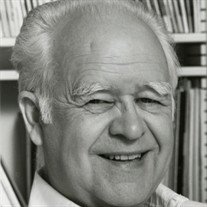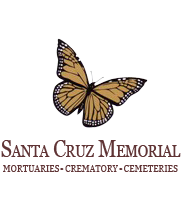


Obituary of Harry Huskey
Please share a memory of Harry to include in a keepsake book for family and friends.
HARRY HUSKEY, COMPUTER PIONEER
Harry Douglas Huskey, a computer pioneer who was part of the famed ENIAC engineering team during World War II, worked with Alan Turing, and designed the Bendix G15, died on Palm Sunday morning at his home in Santa Cruz. He was 101.
Harry Huskey was born in a small farmhouse on Connolly's Creek near Whittier, N. C., close to Smokey Mountain National Park on January 19, 1916. Harry received his bachelor's degree in mathematics and physics at the University of Idaho (1937) and a masters and doctorate in mathematics from Ohio State University (1943). While getting his doctorate, he had a teaching assistantship and taught Geometry. His best student, Velma Roeth, married him a few years later.
Harry's first job was teaching mathematics at the University of Pennsylvania. With two small baby girls he heard there might be extra work opportunities at the Penn's Moore School of Engineering, but the work was classified, so he could not find out anything about it. He applied anyway, and after some weeks was cleared to enter through the locked gates to the ENIAC (Electronic Numerical Integrator and Computer) project (1945). This was the first large scale electronic computer ever built, containing 18,000 vacuum tubes. Once the ENIAC was working in 1946, Harry left the project and accepted an offer of a 1-year appointment at the British National Physical Laboratory (NPL) without knowing what it was. Arriving in England in January 1947, he worked on a new computer prototype called the Pilot ACE. Alan Turing led the project and the computer was a smaller version of the ACE (Automatic Computing Engine) built by Turing some years later. This was an early instance of the idea of the stored-program. Being able to store its own program is one of the defining characteristics of computers today.
In December of 1948, having returned from England to work at the National Bureau of Standards, Harry moved to Los Angeles to design and lead the building of the SWAC (Standards Western Automatic Computer) at UCLA. The machine was intended to support mathematicians at UCLA and the Air Force, since there still were no commercially manufactured computers available. The computer when completed in July 1950, was the fastest computer in the world, and was finally retired in 1967. During his SWAC work, Harry appeared on You Bet Your Life, a live television show hosted by Groucho Marx, in which Harry tried patiently to explain what the SWAC does. Groucho paired Harry up with a junk dealer. Asked how much he thought the SWAC would be worth, the junk dealer asked how much it weighed.
In July 1954, Harry took a faculty position at UC Berkeley, teaching mathematics and electrical engineering. During this period he also worked independently on the design of a computer that did not require a computer center, or computer operators, but could be run by a single person. The computer was sponsored by Bendix computer and was introduced as the Bendix G15 in 1956. The G15 was the first computer that could be called a "personal" computer, in that one person could run it. It could be installed in a home or small business and was roughly the size of a refrigerator. At that time the only computers were large professionally managed systems in computer centers. The G15 cost just under $50,000 or could be rented for $1,500 a month. Harry had one in his home office in Berkeley.
In the 60's the U. S. Agency for International Development worked with the Indian Government to set up an Indian Institute of Technology in Kanpur, U.P., India. In 1963, Harry Huskey left for India to spend a year at IIT Kanpur overseeing the installation of the first computer in India, an IBM 1620. During the year he helped establish the computer center and computer engineering department there. During the 60's and 70's he taught and advised other universities around the world on setting up their own computer centers and computer science programs, including the University of Yangon (Rangoon), Burma with UNESCO support.
In 1967, Harry left Berkeley to join the faculty at the newly formed UC Santa Cruz campus. He was the founder and initial director of the UCSC Computer Center and helped establish the computer and information science programs there.
Later in his career, he and his wife, Velma, became very interested in the history of computing. They were some of the first people to research and write about Lady Ada Lovelace. They spent many weeks in England reading her letters. He retired in 1986.
He received the 1984 Centennial Award from the IEEE, the 1982 Computer Pioneer Award from the IEEE Computer Society; he was honored at the Pioneer Session of the National Computer Conference in 1978 and received the Founding Faculty Award from UCSC in 2015. He wrote books and many articles on computing.
In 1991, Harry's beloved wife of 52 years passed away. Harry moved to Salt Lake City to be nearer his eldest daughter Carolyn. He spent some time visiting his aunts in South Carolina and in 1994 he married Nancy Whitney of Spartanburg, S. C. Spending much time travelling, eventually they settled in Hilton Head, S.C. and later in Spartanburg.
In 2011, Harry returned to Santa Cruz with his wife Nancy. In 2013, the Computer History Museum named him a Museum Fellow "for his seminal work on early and important computing systems and a lifetime of service to computer education." Nancy Huskey passed away in 2015.
Harry is survived by daughter Carolyn (Joe) Dickinson of Aptos, daughter Roxanne Dwyer in Scotts Valley, son Doug (Anna) Huskey in Santa Cruz and daughter Linda (Jerome) Retterath in Santa Clara. He is also survived by 5 grand children, Ann Dickinson, Jeff Dickinson, Phil Dwyer, Jacob Huskey, Noelle Huskey-Mullin, and great grandchild Erin Dickinson as well as one Huskey-Mullin due in June.
To plant a beautiful memorial tree in memory of Harry Huskey, please visit our Tree Store

A Memorial Tree was planted for Harry
We are deeply sorry for your loss ~ the staff at Santa Cruz Mission Chapel
Online Memory & Photo Sharing Event
Ongoing
Online Event
About this Event

In Loving Memory
Harry Huskey
1916 - 2017
Look inside to read what others have shared
Family and friends are coming together online to create a special keepsake. Every memory left on the online obituary will be automatically included in this book.
Services for Harry Huskey
There are no events scheduled. You can still show your support by planting a tree in memory of Harry Huskey.
Plant a tree in memory of Harry
Santa Cruz Mission Chapel
1927 Ocean Street
Santa Cruz, CA 95060
Telephone: (831) 426-1601
California License FD#: 1476
COA #54 | CR#179
Email: info@scmemorial.com
Oakwood Chapel
3301 Paul Sweet Road
Santa Cruz, CA 95065
Telephone: (831) 475-2464
California License FD#: 1530
COA #53
Email: info@scmemorial.com
© All Rights Reserved |
Admin Login | Website powered by FuneralTech & TA | Privacy Policy | Terms of Use

